PORSCHE 911 2014 6.G Information Manual
Manufacturer: PORSCHE, Model Year: 2014, Model line: 911, Model: PORSCHE 911 2014 6.GPages: 75, PDF Size: 11.41 MB
Page 11 of 75
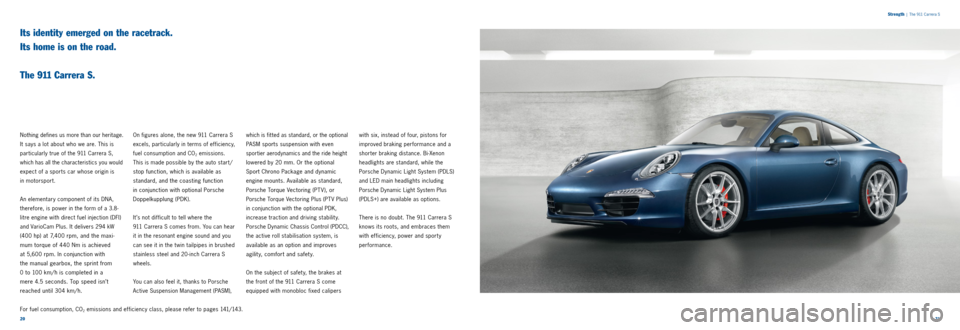
2021
S
trength
| The 911 Carrera S
Its identity emerged on the racetrack.
Its home is on the road.
The 911 Carrera S.
Nothing defines us more than our heritage.
It says a lot about who we are. This is
particularly true of the 911 Carrera S,
which has all the characteristics you would
expect of a sports car whose origin is
in motorsport.
An elementary component of its DNA,
therefore, is power in the form of a 3.8-
litre engine with direct fuel injection (DFI)
and VarioCam Plus. It delivers 294 kW
(400 hp) at 7,400 rpm, and the maxi-
mum torque of 440 Nm is achieved
at 5,600 rpm. In conjunction with
the manual gearbox, the sprint from
0 to 100 km/ h is completed in a
mere 4.5 seconds. Top speed isn’t
reached until 304 km/ h.
On figures alone, the new 911 Carrera S
excels, particularly in terms of efficiency,
fuel consumption and CO
2 emissions.
This is made possible by the auto start /
stop function, which is available as
standard, and the coasting function
in conjunction with optional Porsche
Doppelkupplung (PDK).
It ’s not difficult to tell where the
911 Carrera S comes from. You can hear
it in the resonant engine sound and you
can see it in the t win tailpipes in brushed
stainless steel and 20 -inch Carrera S
wheels.
You can also feel it, thanks to Porsche
Active Suspension Management (PASM),
which is fit ted as standard, or the optional
PASM sports suspension with even
sportier aerodynamics and the ride height
lowered by 20 mm. Or the optional
Sport Chrono Package and dynamic
engine mounts. Available as standard,
Porsche Torque Vectoring (PTV), or
Porsche Torque Vectoring Plus (PTV Plus)
in conjunction with the optional PDK,
increase traction and driving stability.
Porsche Dynamic Chassis Control (PDCC),
the active roll stabilisation system, is
available as an option and improves
agility, comfort and safety.
On the subject of safet y, the brakes at
the front of the 911 Carrera S come
equipped with monobloc fixed calipers with six, instead of four, pistons for
improved braking performance and a
shorter braking distance. Bi-Xenon
headlights are standard, while the
Porsche Dynamic Light System (PDLS)
and LED main headlights including
Porsche Dynamic Light System Plus
(PDLS
+
) are available as options.
There is no doubt. The 911 Carrera S
knows its roots, and embraces them
with efficiency, power and sport y
performance.
For fuel consumption, CO
2 emissions and efficiency class, please refer to pages 141/143.
Page 12 of 75
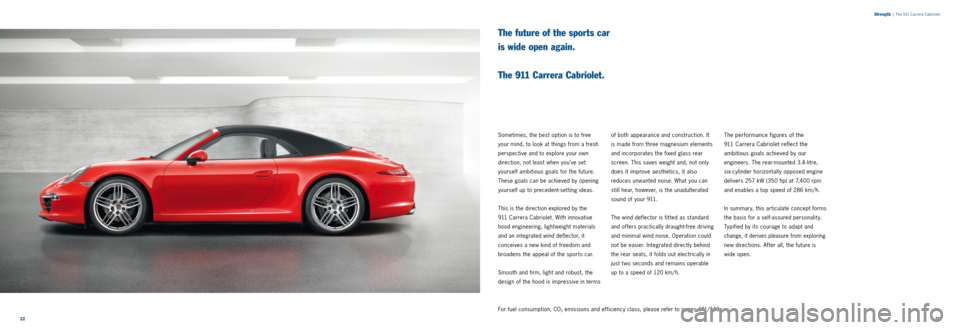
2223
S
trength
| The 911 Carrera Cabriolet
The future of the sports car
is wide open again.
The 911 Carrera Cabriolet.
Sometimes, the best option is to free
your mind, to look at things from a fresh
perspective and to explore your own
direction, not least when you’ve set
yourself ambitious goals for the future.
These goals can be achieved by opening
yourself up to precedent-set ting ideas.
This is the direction explored by the
911 Carrera Cabriolet. With innovative
hood engineering, lightweight materials
and an integrated wind deflector, it
conceives a new kind of freedom and
broadens the appeal of the sports car.
Smooth and firm, light and robust, the
design of the hood is impressive in terms of both appearance and construction. It
is made from three magnesium elements
and incorporates the fixed glass rear
screen. This saves weight and, not only
does it improve aesthetics, it also
reduces unwanted noise. What you can
still hear, however, is the unadulterated
sound of your 911.
The wind deflector is fit ted as standard
and offers practically draught-free driving
and minimal wind noise. Operation could
not be easier. Integrated directly behind
the rear seats, it folds out electrically in
just t wo seconds and remains operable
up to a speed of 120 km/ h.
The performance figures of the
911
Carrera Cabriolet reflect the
ambitious goals achieved by our
engineers. The rear-mounted 3.4-litre,
six-cylinder horizontally opposed engine
delivers
257 kW (350 hp) at 7,400 rpm
and enables a top speed of 286 km/ h.
In summary, this articulate concept forms
the basis for a self-assured personalit y.
Typified by its courage to adapt and
change, it derives pleasure from exploring
new directions. After all, the future is
wide open.
For fuel consumption, CO
2 emissions and efficiency class, please refer to pages 141/143.
Page 13 of 75
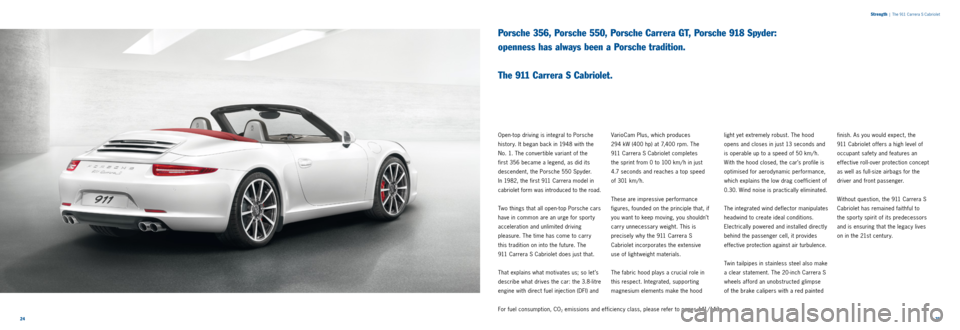
2425
S
trength
| The 911 Carrera S Cabriolet
Porsche 356, Porsche 550, Porsche Carrera GT, Porsche 918 Spyder:
openness has always been a Porsche tradition.
The 911 Carrera S Cabriolet.
Open-top driving is integral to Porsche
history. It began back in 1948 with the
No. 1. The convertible variant of the
first 356 became a legend, as did its
descendent, the Porsche 550 Spyder.
In 1982, the first 911 Carrera model in
cabriolet form was introduced to the road.
Two things that all open-top Porsche cars
have in common are an urge for sport y
acceleration and unlimited driving
pleasure. The time has come to carry
this tradition on into the future. The
911 Carrera S Cabriolet does just that.
That explains what motivates us; so let ’s
describe what drives the car: the 3.8-litre
engine with direct fuel injection (DFI) and
VarioCam Plus, which produces
294 kW (400 hp) at 7,400 rpm. The
911 Carrera S Cabriolet completes
the sprint from 0 to 100 km/ h in just
4.7 seconds and reaches a top speed
of 301 km/ h.
These are impressive performance
figures, founded on the principle that, if
you want to keep moving, you shouldn’t
carry unnecessary weight. This is
precisely why the 911 Carrera S
Cabriolet incorporates the extensive
use of lightweight materials.
The fabric hood plays a crucial role in
this respect. Integrated, supporting
magnesium elements make the hood light yet extremely robust. The hood
opens and closes in just 13 seconds and
is operable up to a speed of 50 km/ h.
With the hood closed, the car’s profile is
optimised for aerodynamic performance,
which explains the low drag coefficient of
0.30. Wind noise is practically eliminated.
The integrated wind deflector manipulates
headwind to create ideal conditions.
Electrically powered and installed directly
behind the passenger cell, it provides effective protection against air turbulence.
Twin tailpipes in stainless steel also make
a clear statement. The 20 -inch Carrera S
wheels afford an unobstructed glimpse
of the brake calipers with a red painted
finish. As you would expect, the
911 Cabriolet offers a high level of
occupant safety and features an
effective roll-over protection concept
as well as full-size airbags for the
driver and front passenger.
Without question, the 911 Carrera S
Cabriolet has remained faithful to
the sporty spirit of its predecessors
and is ensuring that the legacy lives
on in the 21st century.
For fuel consumption, CO
2 emissions and efficiency class, please refer to pages 141/143.
Page 14 of 75
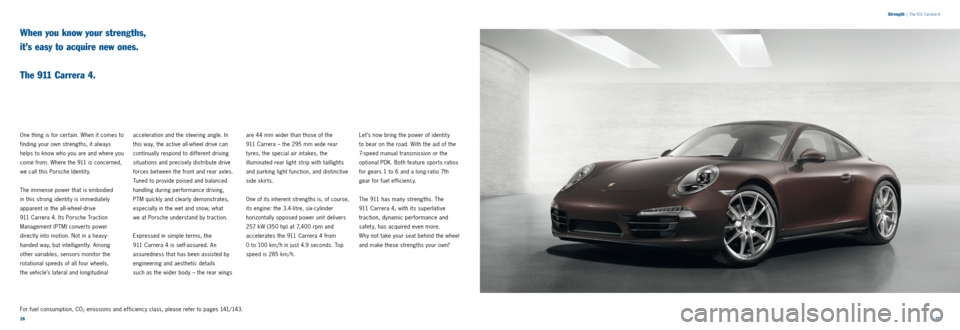
2627
When you know your strengths,
it’s easy to acquire new ones.
The 911 Carrera 4.
One thing is for certain. When it comes to
finding your own strengths, it always
helps to know who you are and where you
come from. Where the 911 is concerned,
we call this Porsche Identit y.
The immense power that is embodied
in this strong identit y is immediately
apparent in the all-wheel-drive
911 Carrera 4. Its Porsche Traction
Management (PTM) converts power
directly into motion. Not in a heav y-
handed way, but intelligently. Among
other variables, sensors monitor the
rotational speeds of all four wheels,
the vehicle’s lateral and longitudinal acceleration and the steering angle. In
this way, the active all-wheel drive can
continually respond to different driving
situations and precisely distribute drive
forces bet ween the front and rear axles.
Tuned to provide poised and balanced
handling during performance driving,
PTM quickly and clearly demonstrates,
especially in the wet and snow, what
we at Porsche understand by traction.
Expressed in simple terms, the
911 Carrera 4 is self-assured. An
assuredness that has been assisted by
engineering and aesthetic details
such as the wider body – the rear wings are 44 mm wider than those of the
911 Carrera – the 295 mm wide rear
tyres, the special air intakes, the
illuminated rear light strip with taillights
and parking light function, and distinctive
side skirts.
One of its inherent strengths is, of course,
its engine: the 3.4-litre, six-cylinder
horizontally opposed power unit delivers
257 kW (350 hp) at 7,400 rpm and
accelerates the 911 Carrera 4 from
0 to 100 km/ h in just 4.9 seconds. Top
speed is 285 km/ h.
Let ’s now bring the power of identit y
to bear on the road. With the aid of the
7-speed manual transmission or the
optional PDK.
Both feature sports ratios
for gears 1 to 6 and a long-ratio 7th
gear for fuel efficiency.
The 911 has many strengths. The
911 Carrera 4, with its superlative
traction, dynamic performance and
safet y, has acquired even more.
Why not take your seat behind the wheel
and make these strengths your own?
For fuel consumption, CO
2 emissions and efficiency class, please refer to pages 141/143.
S trength | The 911 Carrera 4
Page 15 of 75
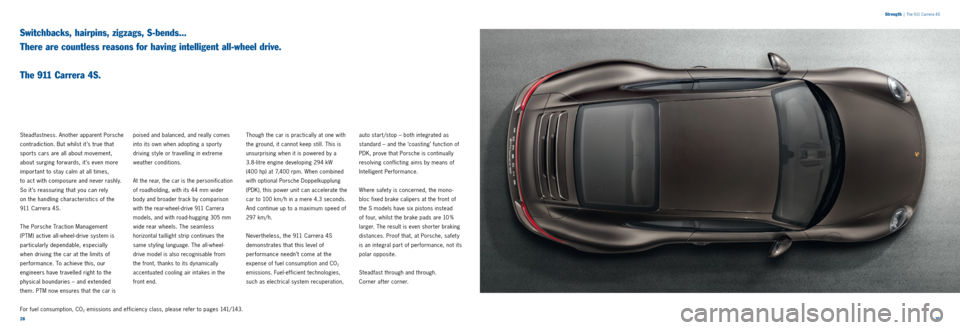
2829
Switchbacks, hairpins, zigzags, S-bends...
There are countless reasons for having intelligent all-wheel drive.
The 911 Carrera 4S.
Steadfastness. Another apparent Porsche
contradiction. But whilst it ’s true that
sports cars are all about movement,
about surging forwards, it ’s even more
important to stay calm at all times,
to act with composure and never rashly.
So it ’s reassuring that you can rely
on the handling characteristics of the
911 Carrera 4S.
The Porsche Traction Management
(PTM) active all-wheel- drive system is
particularly dependable, especially
when driving the car at the limits of
performance. To achieve this, our
engineers have travelled right to the
physical boundaries – and extended
them. PTM now ensures that the car is poised and balanced, and really comes
into its own when adopting a sport y
driving st yle or travelling in extreme
weather conditions.
At the rear, the car is the personification
of roadholding, with its 44 mm wider
body and broader track by comparison
with the rear-wheel- drive 911 Carrera
models, and with road-hugging 305 mm
wide rear wheels. The seamless
horizontal taillight strip continues the
same st yling language. The all-wheel-
drive model is also recognisable from
the front, thanks to its dynamically
accentuated cooling air intakes in the
front end.
Though the car is practically at one with
the ground, it cannot keep still. This is
unsurprising when it is powered by a
3.8-litre engine developing 294 kW
(400 hp) at 7,400 rpm. When combined
with optional Porsche Doppelkupplung
(PDK), this power unit can accelerate the
car to 100 km/ h in a mere 4.3 seconds.
And continue up to a maximum speed of
297 km/ h.
Nevertheless, the 911 Carrera 4S
demonstrates that this level of
performance needn’t come at the
expense of fuel consumption and CO2
emissions. Fuel-efficient technologies,
such as electrical system recuperation,
For fuel consumption, CO
2 emissions and efficiency class, please refer to pages 141/143.
S trength | The 911 Carrera 4S
auto start/stop – both integrated as
standard – and the ‘coasting’ function of
PDK, prove that Porsche is continually
resolving conflicting aims by means of
Intelligent Performance.
Where safety is concerned, the mono -
bloc fixed brake calipers at the front of
the S models have six pistons instead
of four, whilst the brake pads are 10 %
larger. The result is even shorter braking
distances. Proof that, at Porsche, safet y
is an integral part of performance, not its
polar opposite.
Steadfast through and through.
Corner after corner.
Page 16 of 75
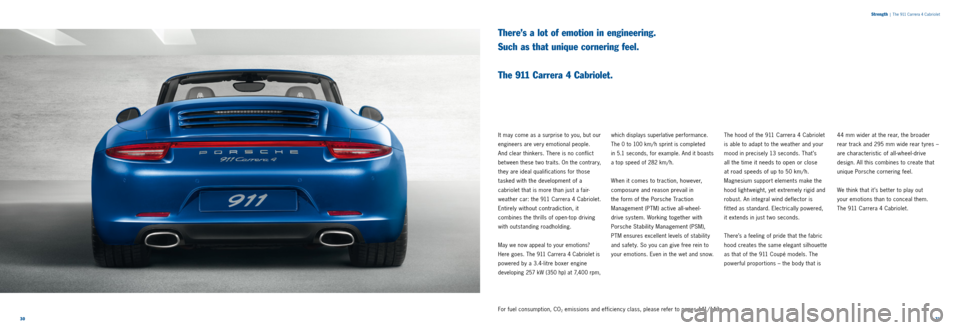
3031
which displays superlative performance.
The 0 to 100 km/ h sprint is completed
in 5.1 seconds, for example. And it boasts
a top speed of 282 km/ h.
When it comes to traction, however,
composure and reason prevail in
the form of the Porsche Traction
Management (PTM) active all-wheel-
drive system. Working together with
Porsche Stability Management (PSM),
PTM ensures excellent levels of stability
and safet y. So you can give free rein to
your emotions. Even in the wet and snow.
It may come as a surprise to you, but our
engineers are very emotional people.
And clear thinkers. There is no conflict
bet ween these t wo traits. On the contrary,
they are ideal qualifications for those
tasked with the development of a
cabriolet that is more than just a fair-
weather car: the 911 Carrera 4 Cabriolet.
Entirely without contradiction, it
combines the thrills of open-top driving
with outstanding roadholding.
May we now appeal to your emotions?
Here goes. The 911 Carrera 4 Cabriolet is
powered by a 3.4-litre boxer engine
developing 257 kW (350 hp) at 7,400 rpm,
S trength | The 911 Carrera 4 Cabriolet
There’s a lot of emotion in engineering.
Such as that unique cornering feel.
The 911 Carrera 4 Cabriolet.
The hood of the 911 Carrera 4 Cabriolet
is able to adapt to the weather and your
mood in precisely 13 seconds. That ’s
all the time it needs to open or close
at road speeds of up to 50 km/ h.
Magnesium support elements make the
hood light weight, yet extremely rigid and
robust. An integral wind deflector is
fit ted as standard. Electrically powered,
it extends in just t wo seconds.
There’s a feeling of pride that the fabric
hood creates the same elegant silhouet te
as that of the 911 Coupé models. The
powerful proportions – the body that is 44 mm wider at the rear, the broader
rear track and 295 mm wide rear t yres –
are characteristic of all-wheel-drive
design. All this combines to create that
unique Porsche cornering feel.
We think that it ’s bet ter to play out
your emotions than to conceal them.
The 911 Carrera 4 Cabriolet.
For fuel consumption, CO
2 emissions and efficiency class, please refer to pages 141/143.
Page 17 of 75

3233
Which vital ingredients do you need to
experience moments of true happiness?
It ’s our conviction, at least, that you need
impressive roadholding. Plus safety,
reliabilit y and faith in technology that won’t
let you down when you need it most.
Because only when we have peace of
mind are we truly free.
All these ingredients have been brought
together in the 911 Carrera 4S Cabriolet.
The car, powered by a 3.8-litre direct fuel
injection (DFI) engine with a maximum
output of 294 kW (400 hp) at 7,400 rpm,
sprints from 0 to 100 km / h in
4.7 seconds and boasts a top speed of
296 km/ h.
Strength | The 911 Carrera 4S Cabriolet
The strength of identity can be measured after all.
In moments of happiness.
The 911 Carrera 4S Cabriolet.
The car’s ‘happiness hub’, however, can
be found in the perfected Porsche
Traction Management (PTM) active all-
wheel-drive control system. Handling is
poised and balanced, particularly when
the car is being driven at its limits. This
makes controlling the car even easier
and driving even more pleasurable.
The hood of the 911 Carrera 4S Cabriolet
lets you open up to the open road. The
fabric hood featuring magnesium elements
is light weight, yet robust and extremely
rigid. It opens in just 13 seconds at road
speeds of up to 50 km/ h. When closed,
it shows off an aerodynamically optimised
silhouet te that has a drag coefficient of just 0.31. Which is also why you can hear
hardly any wind noise.
You can certainly hear the engine though.
The sound is – and remains –
unmistakably Porsche. A crucial quality
for a strong identit y.
It’s possible, of course, to describe
moments of happiness. But it’s far
bet ter to experience them first hand.
The 911
Carrera 4S Cabriolet.
For fuel consumption, CO2 emissions and efficiency class, please refer to pages 141/143.
Page 18 of 75
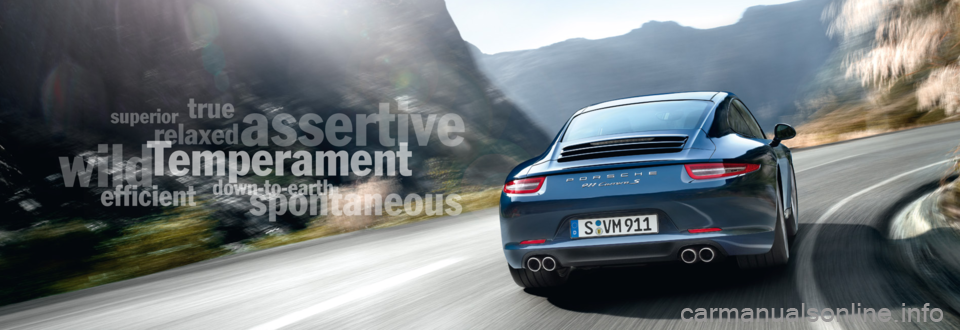
ef\037cient
wild
superior
true
spontaneous
assertive
down-to-earth
T
relaxed
Page 19 of 75
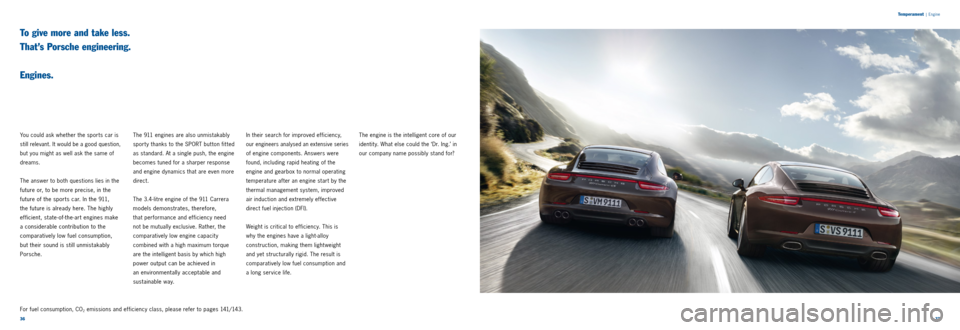
3637
T
emperament
| Engine
To give more and take less.
That’s Porsche engineering.
Engines.
You could ask whether the sports car is
still relevant. It would be a good question,
but you might as well ask the same of
dreams.
The answer to both questions lies in the
future or, to be more precise, in the
future of the sports car. In the 911,
the future is already here. The highly
efficient, state-of-the-art engines make
a considerable contribution to the
comparatively low fuel consumption,
but their sound is still unmistakably
Porsche.
The 911 engines are also unmistakably
sport y thanks to the SPORT but ton fit ted
as standard. At a single push, the engine
becomes tuned for a sharper response
and engine dynamics that are even more
direct.
The 3.4-litre engine of the 911 Carrera
models demonstrates, therefore,
that performance and efficiency need
not be mutually exclusive. Rather, the
comparatively low engine capacity
combined with a high maximum torque
are the intelligent basis by which high
power output can be achieved in
an environmentally acceptable and
sustainable way.
In their search for improved efficiency,
our engineers analysed an extensive series
of engine components. Answers were
found, including rapid heating of the
engine and gearbox to normal operating
temperature after an engine start by the
thermal management system, improved
air induction and extremely effective
direct fuel injection (DFI).
Weight is critical to efficiency. This is
why the engines have a light-alloy
construction, making them lightweight
and yet structurally rigid. The result is
comparatively low fuel consumption and
a long service life. The engine is the intelligent core of our
identit y. What else could the ‘Dr. Ing.’ in
our company name possibly stand for?
For fuel consumption, CO
2 emissions and efficiency class, please refer to pages 141/143.
Page 20 of 75
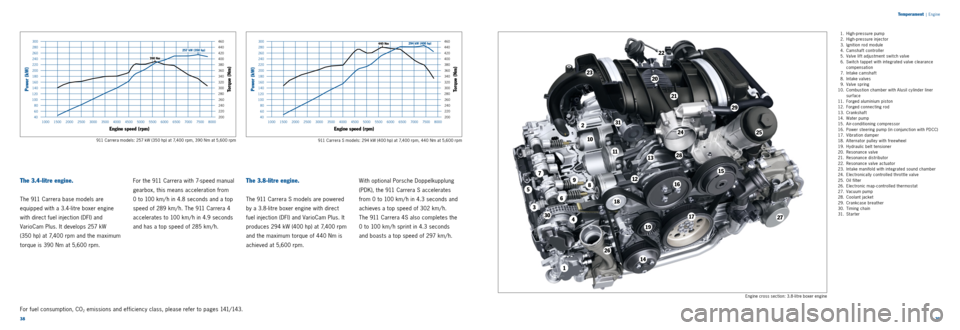
1
2
3
4
5
6
7
89
10
11
12
13
14
15
16
17
18
19
20
21
22
23
2425
26
27
28
29
30
31
3839
T
emperament
| Engine
Engine cross section: 3.8
-litre boxer engine
911 Carrera S models: 294 kW (400 hp) at 7,400 rpm, 440 Nm at 5,600 rpm
1. High - pressure pump
2. High - pressure injector
3. Ignition rod module
4. Camshaf t controller
5. Valve lif t adjustment switch valve
6. Switch tappet with integrated valve clearance
compensation
7. Intake camshaf t
8. Intake valves
9. Valve spring
10. Combustion chamber with Alusil cylinder liner
surface
11. Forged aluminium piston
12. Forged connecting rod
13. Crankshaf t
14. Water pump
15. Air-conditioning compressor
16. Power steering pump (in conjunction with PDCC)
17. Vibration damper
18. Alternator pulley with freewheel
19. Hydraulic belt tensioner
20. Resonance valve
21. Resonance distributor
22. Resonance valve actuator
23. Intake manifold with integrated sound chamber
24. Electronically controlled throt tle valve
25. Oil filter
26. Electronic map -controlled thermostat
27. Vacuum pump
28. Coolant jacket
29. Crankcase breather
30. Timing chain
31. Star ter
911 Carrera models: 257 kW (350 hp) at 7,400 rpm, 390 Nm at 5,600 rpm
The 3.4-litre engine.
The 911 Carrera base models are
equipped with a 3.4-litre boxer engine
with direct fuel injection (DFI) and
VarioCam Plus. It develops 257 kW
(350 hp) at 7,400 rpm and the maximum
torque is 390 Nm at 5,600 rpm.
For the 911 Carrera with 7-speed manual
gearbox, this means acceleration from
0 to 100 km/ h in 4.8 seconds and a top
speed of 289
km/ h. The 911 Carrera 4
accelerates to 100 km/ h in 4.9 seconds
and has a top speed of 285
km/ h.
For fuel consumption, CO
2 emissions and efficiency class, please refer to pages 141/143.
The 3.8-litre engine.
The 911 Carrera S models are powered
by a 3.8-litre boxer engine with direct
fuel injection (DFI) and VarioCam Plus. It
produces 294 kW (400 hp) at 7,400 rpm
and the maximum torque of 440 Nm is
achieved at 5,600 rpm. With optional Porsche Doppelkupplung
(PDK), the 911 Carrera S accelerates
from 0 to 100 km/ h in 4.3 seconds and
achieves a top speed of 302
km/ h.
T h e 911
Carrera 4S also completes the
0 to 100
km/ h sprint in 4.3 seconds
and boasts a top speed of 297
km/ h.
40 60 80
100
120 140 160 180 200 220 240 260
1500 75008000
2000 2500300035004000450050005500600065007000
1000
294 kW (400 hp)440 Nm
300
280
Power (kW)
T orque (Nm)
Engine speed (rpm)
200
280 300 320 340 360 380 400 420
220 240 260
460
44040
60 80
100
120 140 160 180 200 220 240 260
1500 75008000
2000 2500300035004000450050005500600065007000
1000
300
280
Power (kW)
T orque (Nm)
Engine speed (rpm)
200
280 300 320 340 360 380 400 420
220 240 260
460
440
257 kW (350 hp)
390 Nm